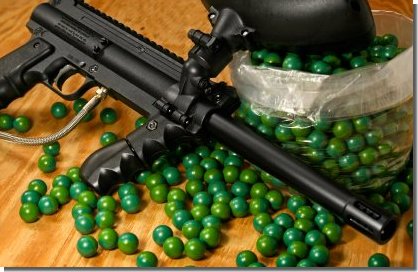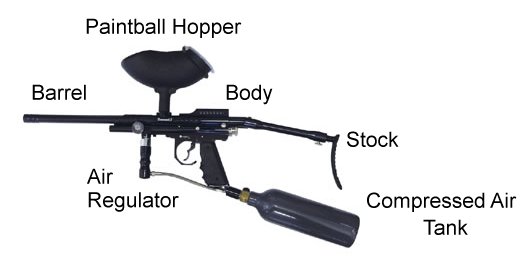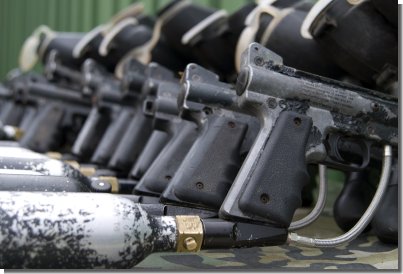The Anatomy of the Paintball Gun (or Marker)
Paintball guns range from the simple to the complex; you can shoot a very basic or starter model all the up to laser-fed, precision-balanced, electronically-triggered paintball guns that fire up to 15 balls per second.

Yeah, that's right: 15 paintballs per second. If you think getting shot with one paintball hurts, imagine the other 14 balls still in the air on their way to you.
The paintball gun, also known as a paintball 'marker', can range from basic to advanced. They also range from cheap (around $60 or so for a basic Tippmann) to the very expensive, bringing $1600 to $2000 or more for a high-end Dye or Angel paintball gun.
All this technology makes paintballing a very competitive sport. Paintball teams, especially those with sponsors, will generally carry the latest cutting edge paintball marking systems and have the latest equipment available.
Basic guns have the advantage of simplicity: there's less to them, so there's less to go wrong. Without electronics, they can be more reliable in the field, and are less prone to malfunction or jamming. They're good backup guns to have and are easy to learn with, especially for beginners.
More advanced paintball guns have far more features. Electrostatic triggers enable players to shoot faster, requring only the slightest touch of the fingertips. Electronic ball feed systems allow for higher rates of fire, and computerized firing mechanisms enable high-end guns to shoot further, straighter, and more accurately.
The Basic Components of a Paintball Gun
All paintball markers have a gun body, a barrel, a paintball hopper, and a compressed air or CO2 tank to propel the balls from the chamber. The diagram below shows the basics of the typical paintball weapon:

Not all guns will have stocks, and most won't. The air regulator is another feature that's sometimes built into the body of a gun; it helps regulate the pressure released during each shot. An external air pressure gauge, like the one shown above, can be very useful in showing when your air tank is almost empty.
How a Paintball Gun Works
A paintball gun is powered by compressed air, usually CO2 or N2 (carbon dioxide or nitrogen gas). These harmless, inert gases are pressured in an external tank and screwed into the back of the gun.
When the trigger is pulled, air is released into the expansion chamber or air regulator. From here, a measured burst of air is directed into the upper body of the gun.
It's this burst of air that rockets forward the firing pin, launching the ball through the barrel. In another (usually the lower) part of the paintball marker, a portion of that air is used to re-cock the firing pin to it's original position, readying it for the next round.
Cocking and Firing the Paintball Gun
Inside the body of your paintball marker is the firing chamber. Balls are fed into this chamber from the hopper, usually located above the gun for a downward gravity-driven feed.
The bolt that fires the ball from the barrel is known as the Venturi bolt. There are all different after-market bolts you can install in your gun (usually made of lightweight aluminum) that will increase firing speed and cut down on the reload time for each new ball entering the firing chamber.
Your paintball gun needs to be cocked only once; right before you begin shooting. From that point on, the gun is automatically cocked each time a ball is fired. A portion of the same gas (from the CO2 or N2 compressed air tank) that fires the gun is also used to drive the Venturi bolt back into a firing position.
Autococker, an early gun manufacturer, was the first real 'closed bolt' system: the increased pressure allowed for faster cocking and firing of the gun itself.
Shooting Straight - Paintball Gun & Barrel Options
Half of paintball is getting into proper position to shoot your opponent. The other half? Actually hitting him.
Your paintball marker goes a LONG way toward determining how good you'll be. Shooting straight, far, and accurately means have a good, clean weapon that's working properly and firing right.

You can't put your paintballs on the enemy team if your gun is jammed, clogged, or gummed up with broken paintballs. Your gun should be clean and ready, or you'll end up having a really bad day (and lots of missed games).
Unfortunately, most fields have rental guns that have been beaten completely to shit. Their guns are the standard Tippmann models seen here to the right; overall they're a decent weapon, but not if they're dirty or damaged or scraped up both inside and out.
Renting these guns is almost silly: you might as well buy your own. Beginner paintball guns are cheap, easy to learn, and shoot ten times better than anything you'd get from some scuzzy beaten-down paintball field rental.
In fact, do the math yourself. Check out some good first guns and starter packages below:
Some of these ready-to-play paintball kits are under $100. You're getting brand new, squeaky-clean equipment instead of that filth-smeared rental crap.
Remember: dirty gun will always misfire. Your paintballs will break before they leave the barrel, or fire off at crazy angles and do weird acrobatics as they fly off covered in paint and debris. Trust me when I say this isn't just frustrating... it will ruin your whole day.
Broken paintballs in the barrel or firing bolt mean the gun needs to be broken down and thoroughly cleaned, sometimes even right there on the battlefield. A pull-through paintball squeegee and a good rag can help tremendously, but it won't always solve the problem. Get your gun cleaned and straightened out before you come to the field, and you'll be a much happier and more successful player.
Advanced Paintball Gun Components
Going beyond the basic gun, there are lots of add-ons and enhancements that can really trick out a paintball marker. Pros and speedball teams will always be on top of the latest weapon systems, and paintball tech has come a LONG way since the early days.
